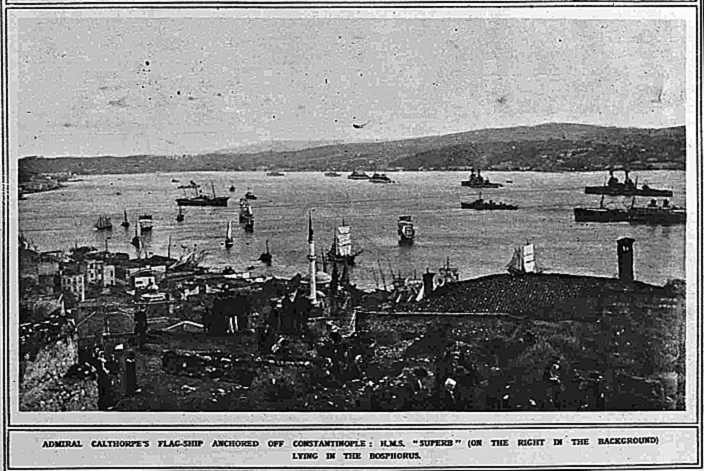
- Allied warships anchored off Constantinople in November 1918. Photo from London Illustrated News.
On October 30th, 1918, the Armistice of Mudros brought hostilities between the Ottoman Empire and the Allies to an end as of noon the following day. The agreement was reached on board the British battleship HMS Agamemnon, a ship with two Lutonians among its crew.
Following the Mudros signing, ships of Britain, France, Italy and Greece sailed through the infamous Dardanelles straits to the then Turkish capital of Constantinople (Istanbul). Able Seaman Leonard Beale Briers (J22883), of 1 Chiltern Rise, Luton, and Ordinary Seaman Arthur James Claridge (J70352), of Park Road Cottages, Stopsley, sent a letter about the journey to Constantinople which was published in the December 19th, 1918 edition of The Luton News. It read:
“The order of the line was: Battleships: HMS Superb (flagship), HMS Temeraire, HMS Lord Nelson (flagship), HMS Agamemnon; cruisers: HMS Canterbury, HMS Skirmisher, HMS Liverpool, HMS Sentinel, HMS Forward, HMS Foresight, and ten destroyers. Next came the French squadron, consisting of battleships and destroyers, followed by the Italian ships and, last of all, the Greeks.
“We left Mudros Harbour at 4am on November 12th and passed the island of Imbros, where we had a good view of the monitor Raglan. This was sunk on January 20th by the Goeben, and her fighting top and tripod masts are still above the water line.
“We entered the Dardanelles at 12.30pm and saw the SS River Clyde, which was used in the 1915 campaign. In steaming through one realised what England was up against when we tried to force the Dardanelles. Batteries of heavy guns are looming up on both sides, particularly at Chanak [Cannakale], where the channel is only 1,200 yards across.
“We entered the Sea of Marmara about 5pm, and eased down to arrive at Constantinople by daylight next day. We were in sight of the city by 7am on the 13th, and anchored at 8am in the harbour.
“Needless to say, it was a wonderful sight to see all the ships at anchor that morning, which must have made the Turks realise what they had been up against.
“We left Constantinople at 12.30pm the same day and proceeded up the Gulf of Ismid, which is east of the city and 50 miles in length. It is very mountainous on both sides. We anchored off the town of Ismid, which dates back to 327 BC.”
The letter writers were next expecting to sail through the Bosphorus into the Black Sea and on to Sebastopol.

